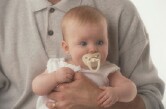- Skip Storing This Everyday Product in the Fridge Door
- Green Tea + B3 Pairing May Boost Brain Health
- Navigating Your Midlife Crisis: Embracing New Possibilities
- City Raccoons Showing Signs of Domestication
- Mapping the Exposome: Science Broadens Focus to Environmental Disease Triggers
- One Week Less on Social Media Linked to Better Mental Health
- Your Brain Changes in Stages as You Age, Study Finds
- Some Suicide Victims Show No Typical Warning Signs, Study Finds
- ByHeart Formula Faces Lawsuits After Babies Sickened With Botulism
- Switch to Vegan Diet Could Cut Your Greenhouse Gas Emissions in Half
Study Shows Benefits of Building Baby’s Language Skills Early


Training infants to identify sounds linked with language before they’re old enough to speak hastens language-associated brain development, a new study suggests.
“Young babies are constantly scanning the environment to identify sounds that might be language,” April Benasich, director of the Infancy Studies Laboratory at Rutgers University’s Center for Molecular and Behavioral Neuroscience, said in a university news release.
“This is one of their key jobs — as between 4 and 7 months of age they are setting up their pre-linguistic acoustic maps. We gently guided the babies’ brains to focus on the sensory inputs which are most meaningful to the formation of these maps,” she explained.
Four-month-old babies were taught to pay attention to increasingly complex sound patterns and were rewarded when they detected a slight sound change. When they reached 7 months of age, these babies were faster and more accurate at detecting language-related sounds than those who hadn’t been exposed to the sound patterns at the earlier age, the investigators found.
The findings suggest that this type of training may be ideal for babies when they’re 4 months old, according to Benasich.
“If you shape something while the baby is actually building it, it allows each infant to build the best possible auditory network for his or her particular brain. This provides a stronger foundation for any language (or languages) the infant will be learning,” she said.
“Compare the baby’s reactions to language cues to an adult driving a car,” Benasich continued. “You don’t think about specifics like stepping on the gas or using the turn signal. You just perform them. We want the babies’ recognition of any language-specific sounds they hear to be just that automatic.”
The study appears in the Oct. 1 issue of the Journal of Neuroscience.
More information
The American Speech-Language-Hearing Association explains how to encourage children’s speech and language development.
Source: HealthDay
Copyright © 2025 HealthDay. All rights reserved.










